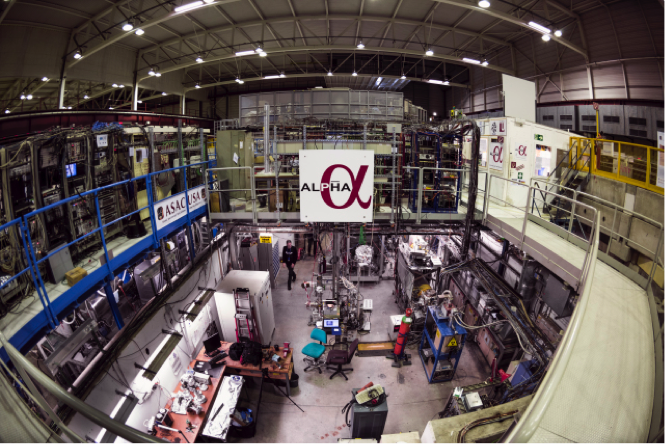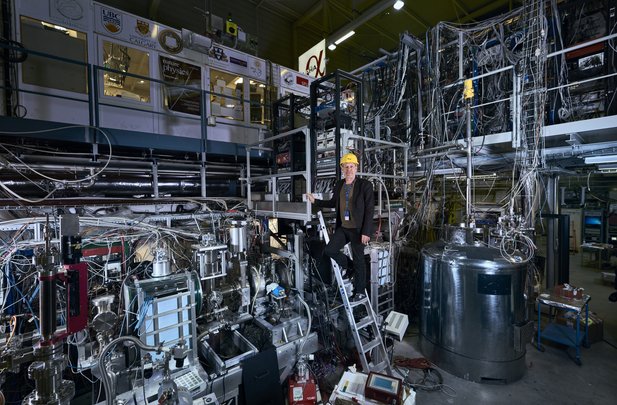Most precise determinations of fine structure in anti-hydrogen reported in this week's Nature
The most precise spectroscopic measurement of antimatter so far is reported in a paper published in Nature this week. The findings confirm the capabilities of anti-atom spectroscopy and bring the development of ultra-sensitive tests of antimatter one step closer.

A long-standing challenge for physicists has been to explain why matter, rather than antimatter, survived the Big Bang. It is thus of paramount importance to gain access to antimatter and understand its properties. In spectroscopy, the properties of atomic transitions are determined by exciting atoms with a laser and examining how they absorb or emit light. Although the same technique can be applied to study anti-atoms, antimatter is difficult to produce and trap, so its properties are difficult to measure.

Jeffrey Hangst in the ALPHA targethall on CERN.
In 2017, CERN’s ALPHA collaboration reported the experimental observation of the laser-driven 1S–2S transition — from the ground state to an excited state — in antihydrogen in a paper published in Nature. Now, Jeffrey Hangst and colleagues from the same collaboration present a detailed characterization of one of the hyperfine components of this transition. The authors studied about 15,000 atoms of antihydrogen, which they magnetically trapped in a cylindrical volume 280 mm long and with a diameter of 44 mm. Their measurements, conducted over a period of ten weeks, reveal that the resonance frequency for the considered transition in antihydrogen agrees with the expected frequency for the 1S–2S transition in hydrogen, with a precision of two parts in a trillion. (Text: Rebecca Walton, Nature)
CONTACT
Jeffrey Hangst (Aarhus University, Aarhus, Denmark)
E-mail: jeffrey.hangst@cern.ch
The Nature paper is titeled 'Characterization of the 1S–2S transition in antihydrogen'.
More background:
A new era of precision for antimatter research
The ALPHA experiment at CERN has measured a light-induced transition in antihydrogen" "with unprecedented precision
The ALPHA collaboration has reported the most precise direct measurement of antimatter ever made, revealing the spectral structure of the antihydrogen atom in unprecedented colour. The result, published today in Nature, is the culmination of three decades of research and development at CERN, and opens a completely new era of high-precision tests between matter and antimatter.
The humble hydrogen atom, comprising a single electron orbiting a single proton, is a giant in fundamental physics, underpinning the modern atomic picture. Its spectrum is characterised by well-known spectral lines at certain wavelengths, corresponding to the emission of photons of a certain frequency or colour when electrons jump between different orbits. Measurements of the hydrogen spectrum agree with theoretical predictions at the level of a few parts in a quadrillion (1015) — a stunning achievement that antimatter researchers have long sought to match for antihydrogen.
Comparing such measurements with those of antihydrogen atoms, which comprise an antiproton orbited by a positron, tests a fundamental symmetry called charge-parity-time (CPT) invariance. Finding any slight difference between the two would rock the foundations of the Standard Model of particle physics and perhaps shed light on why the universe is made up almost entirely of matter, even though equal amounts of antimatter should have been created in the Big Bang. Until now, however, it has been all but impossible to produce and trap sufficient numbers of delicate antihydrogen atoms, and to acquire the necessary "optical interrogation technology, to make serious antihydrogen spectroscopy possible."
The ALPHA team makes antihydrogen atoms by taking antiprotons from CERN’s Antiproton Decelerator (AD) and binding them with positrons from a sodium-22 source. Next it confines the resulting antihydrogen atoms in a magnetic trap, which prevents them from coming into contact with matter and annihilating. Laser light is then shone onto the trapped antihydrogen atoms, their response measured and finally compared with that of hydrogen. In 2016, the ALPHA team used this approach to measure the frequency of the electronic" "transition between the lowest-energy state and the first excited state (the so-called 1S to 2S" "transition) of antihydrogen with a precision of a couple of parts in ten billion, finding good agreement with the equivalent transition in hydrogen. The measurement involved using two laser frequencies — one matching the frequency of the 1S–2S transition in hydrogen and another “detuned” from it — and counting the number of atoms that dropped out of the trap as a result of interactions between the laser and the trapped atoms.
The latest result from ALPHA takes antihydrogen spectroscopy to the next level, using not just one but several detuned laser frequencies, with slightly lower and higher frequencies than the 1S–2S transition frequency in hydrogen. This allowed the team to measure the spectral shape, or spread in colours, of the 1S–2S antihydrogen transition and get a more precise measurement of its frequency. The shape matches that expected for hydrogen extremely well, and ALPHA was able to determine the 1S–2S antihydrogen transition frequency to a precision of a couple of parts in a trillion—a factor of 100 better than the 2016 measurement.
“The precision achieved in the latest study is the ultimate accomplishment for us,” explains Jeffrey Hangst, spokesperson for the ALPHA experiment. “We have been trying to achieve this precision for 30 years and have finally done it.” Although the precision still falls short of that for ordinary hydrogen, the rapid progress made by ALPHA suggests hydrogen-like precision in antihydrogen — and thus unprecedented tests of CPT symmetry — are now within reach.
“This is real laser spectroscopy with antimatter, and the matter community will take notice,” adds Hangst. “We are realising the whole promise of CERN’s AD facility; it’s a paradigm change.”
Read also: The ALPHA experiment explores the secrets of antimatter: press.cern/update/2017/08/alpha-experiment-explores-secrets-antimatter.
ALPHA experiment observes the light spectrum of antimatter for the first time: press.cern/press-releases/2016/12/alpha-experiment-observes-light-spectrum-antimatter-first-time
Photo/Video material:. Youtube short video for online media: youtu.be/gsHUsLnqViw.
More footage – high resolution: videos.cern.ch/record/2310864.
Photos: cds.cern.ch/record/2309883 / cds.cern.ch/record/2238961/ cds.cern.ch/record/2121303
